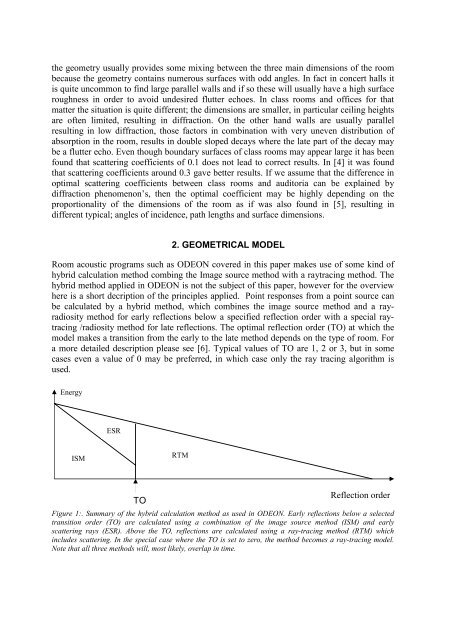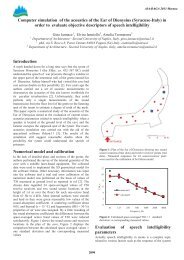Predicting Acoustics in Class Rooms - Odeon
Predicting Acoustics in Class Rooms - Odeon
Predicting Acoustics in Class Rooms - Odeon
Create successful ePaper yourself
Turn your PDF publications into a flip-book with our unique Google optimized e-Paper software.
the geometry usually provides some mix<strong>in</strong>g between the three ma<strong>in</strong> dimensions of the room<br />
because the geometry conta<strong>in</strong>s numerous surfaces with odd angles. In fact <strong>in</strong> concert halls it<br />
is quite uncommon to f<strong>in</strong>d large parallel walls and if so these will usually have a high surface<br />
roughness <strong>in</strong> order to avoid undesired flutter echoes. In class rooms and offices for that<br />
matter the situation is quite different; the dimensions are smaller, <strong>in</strong> particular ceil<strong>in</strong>g heights<br />
are often limited, result<strong>in</strong>g <strong>in</strong> diffraction. On the other hand walls are usually parallel<br />
result<strong>in</strong>g <strong>in</strong> low diffraction, those factors <strong>in</strong> comb<strong>in</strong>ation with very uneven distribution of<br />
absorption <strong>in</strong> the room, results <strong>in</strong> double sloped decays where the late part of the decay may<br />
be a flutter echo. Even though boundary surfaces of class rooms may appear large it has been<br />
found that scatter<strong>in</strong>g coefficients of 0.1 does not lead to correct results. In [4] it was found<br />
that scatter<strong>in</strong>g coefficients around 0.3 gave better results. If we assume that the difference <strong>in</strong><br />
optimal scatter<strong>in</strong>g coefficients between class rooms and auditoria can be expla<strong>in</strong>ed by<br />
diffraction phenomenon’s, then the optimal coefficient may be highly depend<strong>in</strong>g on the<br />
proportionality of the dimensions of the room as if was also found <strong>in</strong> [5], result<strong>in</strong>g <strong>in</strong><br />
different typical; angles of <strong>in</strong>cidence, path lengths and surface dimensions.<br />
2. GEOMETRICAL MODEL<br />
Room acoustic programs such as ODEON covered <strong>in</strong> this paper makes use of some k<strong>in</strong>d of<br />
hybrid calculation method comb<strong>in</strong>g the Image source method with a raytrac<strong>in</strong>g method. The<br />
hybrid method applied <strong>in</strong> ODEON is not the subject of this paper, however for the overview<br />
here is a short decription of the pr<strong>in</strong>ciples applied. Po<strong>in</strong>t responses from a po<strong>in</strong>t source can<br />
be calculated by a hybrid method, which comb<strong>in</strong>es the image source method and a rayradiosity<br />
method for early reflections below a specified reflection order with a special raytrac<strong>in</strong>g<br />
/radiosity method for late reflections. The optimal reflection order (TO) at which the<br />
model makes a transition from the early to the late method depends on the type of room. For<br />
a more detailed description please see [6]. Typical values of TO are 1, 2 or 3, but <strong>in</strong> some<br />
cases even a value of 0 may be preferred, <strong>in</strong> which case only the ray trac<strong>in</strong>g algorithm is<br />
used.<br />
Energy<br />
ISM<br />
ESR<br />
TO<br />
RTM<br />
Reflection order<br />
Time<br />
Figure 1:. Summary of the hybrid calculation method as used <strong>in</strong> ODEON. Early reflections below a selected<br />
transition order (TO) are calculated us<strong>in</strong>g a comb<strong>in</strong>ation of the image source method (ISM) and early<br />
scatter<strong>in</strong>g rays (ESR). Above the TO, reflections are calculated us<strong>in</strong>g a ray-trac<strong>in</strong>g method (RTM) which<br />
<strong>in</strong>cludes scatter<strong>in</strong>g. In the special case where the TO is set to zero, the method becomes a ray-trac<strong>in</strong>g model.<br />
Note that all three methods will, most likely, overlap <strong>in</strong> time.

















